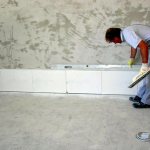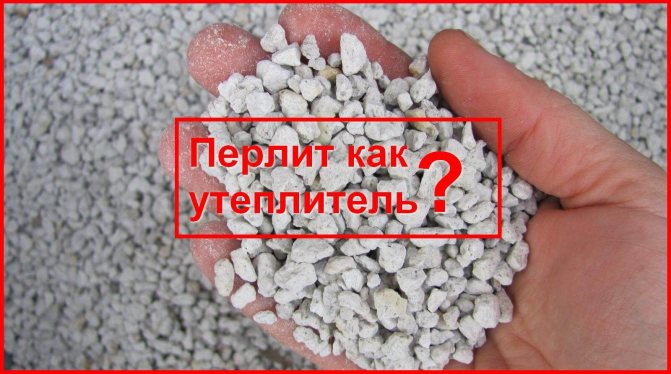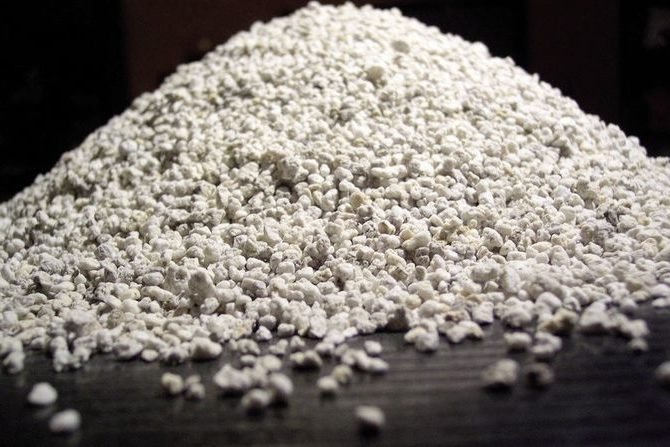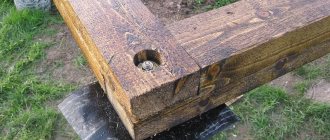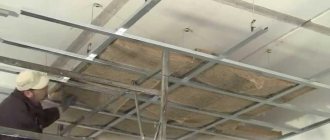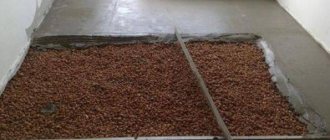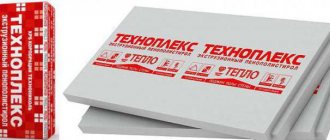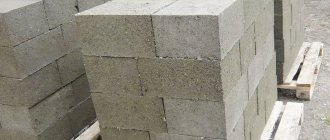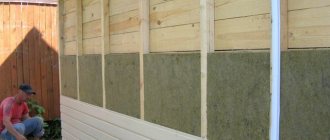Perlite: a new word in the insulation market
Perlite is considered a versatile material used as insulation for walls and floors. This is volcanic sour glass. Raw materials can be obtained by sharp heating up to 1100 degrees, when it swells. Fractional composition is different. Various components are added to the raw materials that improve heat and sound insulation properties.
Today this insulation is considered one of the most effective in the world. Due to its special properties, the product is used not only in construction, but also in other areas. The largest producer of perlite is the United States.
Application area
Expanded perlite M75 GOST10832-2009 (construction)
Natural environmentally friendly material obtained as a result of heat treatment of volcanic rock. Due to its porous structure, perlite is a highly efficient heat and sound insulation material. Expanded perlite has excellent sorption properties, is fire-resistant, bio-resistant, chemically inert and has an unlimited shelf life and use.
The use of perlite is possible in the temperature range from -200 C to 875 C. Perlite is absolutely safe for humans, does not cause allergic reactions and skin irritation, does not harm the climate of the room. Perlite is not flammable, when heated, perlite does not emit harmful substances, products made of expanded perlite increase the fire resistance of the structure several times. Depending on the grain size composition, perlite is subdivided into types:
- VPK (expanded perlite large) particle size from 1.25 to 5.0 mm.
- VPM (expanded perlite fine) particles from 0.16 to 1.25 mm.
- External heat-insulating plaster
- Lightweight plaster for interior use
- Bulk thermal insulation for well masonry (door window slopes)
- Lightweight mortar
- Seamless bulk heat and sound insulation of floors, insulation against the ground.
- Heat-insulating lightweight floor screed
- Seamless bulk roof insulation.
For flowers, perlite is used as a baking powder.
In its natural form, the mineral is used in various economic areas:
- the food and medical industry uses the mineral as a cleaning filter;
- in agriculture, perlite loosening additives are popular.
Wall insulation
Perlite insulates the walls between two rows of bricks
Perlite is popular as a heater for walls of a frame house or a brick building, erected by the method of well masonry. The use of a mineral filler reduces the cost of the overall construction estimate. The thickness of the layer depends on the climatic conditions of the region. It is calculated at the stage of preparing a house construction project.
Thermal insulation with pearlite sand begins at the initial stage of wall construction. Its recommended bulk density is 60-100 kg / m3. When insulating the basement and basement, sand is added to the plaster mix. After the end of the masonry, the structure is covered with floor slabs. They are carefully sealed with a solution so that moisture does not get into the cracks.
Roof insulation
Perlite thermal insulation is used to insulate flat roofs, attic and interfloor ceilings, and floors. For roofs of complex shapes, a special material has been created - bitumen perlite. This is a composition of pearlite sand and heated bitumen. The slabs are given the desired shape. Among the advantages of the product are fire resistance and good thermal insulation characteristics. Perlite-bitumen materials can be used at low negative temperatures.
Scope of application of perlite as insulation
Since the insulation is available in different forms, it can be used in different areas. Perlite is used in:
- energy;
- construction of private and multi-storey buildings;
- metallurgical, food and oil refining industries;
- medicine.
Insulation can be used for external plastering of walls of buildings, when leveling and insulating internal surfaces. In this way, not only heat preservation is ensured, but also a change in the acoustic properties of the structure. Perlite is required to treat the roof. The material is also used when arranging a warm floor.
Perlite sand is used to make building mixtures. They are suitable for filling joints, cracks, cavities in walls, providing thermal insulation properties.

Advantages and disadvantages
Perlite is a finely porous material, this is what ensures its lightness and the unique property of thermal insulation. Volcanic sand occupies a reliable position in construction, having many advantages:
- does not deform at high and low temperatures;
- hypoallergenic material;
- does not emit toxic compounds;
- has a high degree of sound insulation;
- when filling the frame with perlite, it is not required to strengthen the strength of the structure;
- ideal for indoor and outdoor insulation;
- relatively inexpensive price.
- it is not recommended to use perlite in rooms with stably high humidity of 12-15%;
- in the process of work, aluminosilicate dust is released from the material, therefore, open areas of the body and mucous membranes must be covered with clothing and a protective mask.
Insulation features
Insulation can be laid in different ways, it all depends on the type of material. If you need to fill it up, then you should do it right from the bag. In this case, a convenient interval must be observed. You need to check the material to make sure it is dry. If there are cracks or holes in the walls, then they need to be repaired so that the perlite does not spill out.
Cavities in the wall, which are located under windows and doorways, are subject to insulation. If necessary, the material is rammed. Insulation is also required between the exterior masonry and the interior trim.
(in volume fractions):
External heat-insulating plaster:
Compared to ordinary plasters, perlite plasters, due to their high porosity, have 2-4 times less volumetric weight and 4-6 times less thermal conductivity. At the same time, the sound absorption coefficient of heat-insulating perlite plaster is 0.2-0.65, and that of ordinary sandy ones is 0.015 -0.2 (at a frequency of 1000 Hz). Mortar mixtures on fine perlite VPM* have high plasticity, workability and erasability.
Perlite plaster mixes do not crack or shrink when dry.
Thermal conductivity λ - 0.15-0.2 W / (mK)
Vapor permeability µ-0.22
Compressive strength -24 -34 kg / cm2
Sound absorption coefficient at 1000Hz - 0.5
Lightweight plaster for interior use:
When decorating walls and ceilings indoors, the strength characteristics and frost resistance of plaster coatings are not as important as for outdoor plasters: they do not experience temperature changes, the rooms are usually dry. The optimal compositions of mixed perlite solutions with clay or lime as finely dispersed plasticizing additives are compositions 1: 2: 6 - 1: 3: 8 (by volume - cement: lime: VPM perlite*). Mixtures of this composition have a fairly high plasticity and workability, and solutions have a relatively low bulk density and sufficient porosity. The surface of the plaster is well rubbed, it turns out smooth, without defects. Therefore, they are prepared with the addition of lime or clay to make the solutions more plastic and mash. In these formulations, you can replace lime with clay or building sand at the same proportions.However, in this case, the volumetric weight of the plaster increases slightly, the thermal conductivity increases, and the rubbing ability worsens.
Thermal conductivity λ - 0.10-0.11 W / (mK))
Vapor permeability µ-0.22
Compressive strength -8 -9 kg / cm2
Sound absorption coefficient at 1000Hz - 0.5
Light masonry mortar:
Lightweight mortars based on expanded perlite VPM are widely used*... Mixed in a dry state with cement, such compositions are mixed with water directly on the construction site and laid. They fill cavities in walls, blocks, bricks, and grout joints and cracks. This composition of the mixture has the following characteristics:
-Average density - 650kg / m3.
- Tensile strength - more than 1.7N / m2.
-Compression strength - 60kg / m2.
-Thermal conductivity - 0.26W / mK.
An air-entraining additive is used in the form of (emulsion or liquid soap)***... Such a solution is most interesting when building from lightweight bricks or foam concrete, the properties of which are close to their thermal parameters and characteristics of the solution. Masonry on such mortars does not have cold bridges.
Thermal conductivity λ - 0.26 W / (mK))
Vapor permeability µ-0.16
Compressive strength -60kg / cm2
Sound absorption coefficient at 1000Hz - 0.5
Heat-insulating lightweight floor screed:
In the construction of residential, public and industrial buildings in order to create adequate thermal protection in the ceilings above the basement and to ensure reliable sound insulation of interfloor floors, the use of perlite solutions is optimal, since these solutions meet the requirements of SNiP and those. Conditions. The main requirements for flooring on a concrete base due to the high thermal conductivity and heat absorption of reinforced concrete are:
-The coefficient of heat assimilation - no more than 5 kcal / m2.h. C
- Ultimate compressive strength - not less than 45kg / cm2.
These requirements are met by cement-sand perlite mortars, which include expanded perlite of the VPK grade** bulk weight 80-150kg / m2. To increase the mobility of the mixture, surface-active air-entraining additives can be added. The thickness of the fill on the interfloor floors is 30mm, above the unheated technical underground - no more than 100mm.
Such perlite solutions are especially popular during the installation of Warm Floor systems, since perlite is not prone to expansion when heated, does not shrink, and is absolutely not flammable.
Thermal conductivity λ - 0.10 W / (mK))
Vapor permeability µ-0.15
Compressive strength -45-50kg / cm2
Sound absorption coefficient at 1000Hz - 0.5
Attention is important !:
When mixing perlite solutions, initially the mixture turns out to be dry and crumbly, do not rush to add more water, let the batch stand for 10-15 minutes, during which time the perlite will give water. Stir the mixture thoroughly to obtain a plastic solution. Water is given in approximate quantities. The exact amount is selected depending on indicators such as air humidity and sand frequency.
Bulk thermal insulation for well masonry:
Perlite backfills in wall structures are used to protect premises from overheating and hypothermia. As world practice shows, perlite is very successfully used in construction, as a fireproof bulk insulation. Possessing fluidity, when falling asleep, it fills voids of irregular shape. Perlite VPK** can be filled up both with new construction and with the insulation of already built houses, which have air gaps in the walls. If necessary, perlite can be poured into the structure, if possible, tamp and top up. All openings that can be in the wall and through which the perlite insulation can pour out must be closed by the time the perlite is filled up.Filling is carried out both from bags and by means of special sandblasting machines.
Seamless bulk heat and sound insulation of floors:
Expanded VPK perlite is used for the installation of insulated monolithic floors, relative to the ground or basement and between floors**... Perlite is poured out of the bags onto the base and spread with leveling strips so that the thickness of the perlite layer exceeds the desired thickness by 20%. The minimum installation thickness is 1cm. Pipelines and other irregularities are buried in a layer of bulk material. The entire surface is covered with slabs, on top of which a monolithic coating is made. If such layers are not mounted on the basement floor, then, first of all, drainage pipes are laid to accumulate and remove moisture. An absorbent protective pad, such as kraft paper (but not foils), is placed under the layer. When installing wooden floors, the expanded perlite is laid without compaction. Any cavities between beams and lumber are filled without difficulty, without loss of insulation for various cuttings. The non-combustibility of perlite increases the fire safety of the floor structure. If it is necessary to prevent dusting and strengthen the upper layer, the layer is sprinkled with cement, followed by light wetting. Perlite will allow you to quickly achieve evenness and at the same time create a high-quality sound insulation layer between floors.
Properties and advantages of perlite
Such insulation for walls as perlite has the following advantages and properties.
- light weight, which makes it possible not to carry out additional strengthening of the strength of the walls - the structures remain light, and the load on the foundation practically does not increase;
- resistance to temperature extremes, therefore, the material can be used to isolate internal and external surfaces (the material can withstand -220 - +900 degrees);
- environmental friendliness: the insulation does not emit toxins, regardless of the operating conditions;
- hypoallergenic;
- fire resistance - the insulation not only does not burn, but also protects structures from ignition;
- resistance to aggressive chemicals: it is not affected by alkalis and acids;
- inertness to corrosion;
- providing a high level of sound insulation;
- no deformation when exposed to heat in the room;
- the average cost in comparison with other materials, especially since its use pays off within a few years after the start of operation, since the cost of heating the house is reduced;
- ease of use, high efficiency;
- bulk density - 45-500 kg / m3;
- thermal conductivity - 0.043-0.053 W / mK;
- porosity - 70-90%.
But pearlite also has some disadvantages. You should not insulate the walls with this material if the rooms are constantly humid. During work, protective equipment and protective clothing should be used, as perlite emits aluminosilicate dust. It irritates the mucous membranes of the respiratory tract.
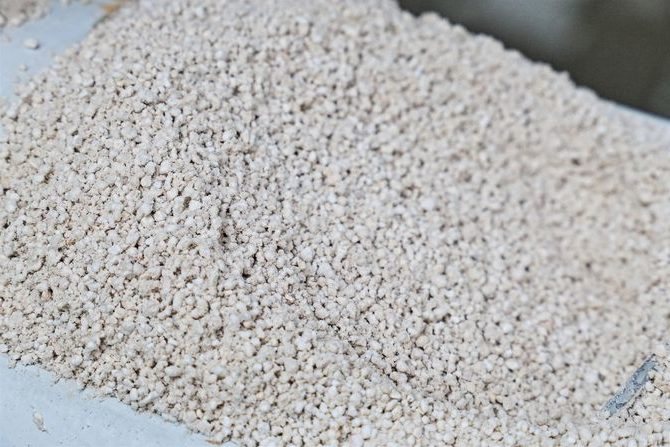

Characteristics and properties of the material
Perlite belongs to rocks of volcanic origin. By itself, natural material has no particular value for construction. It looks like ordinary rubble. Perlite is unique due to its special heat treatment.
In order for the rock to have the necessary technical characteristics, it is heated to a temperature of 1100 degrees. Under the influence of the high mode, the pores of the material explode - swelling. As a result, perlite breaks down into many particles of various fractions.
The processed perlite has the following technical characteristics:
- fire resistance;
- bulk density (depends on the size of material fractions) - from 45 to 500 kg / m3;
- thermal conductivity level - from 0.043 to 0.053 W / mK;
- the ability to withstand temperature conditions from - 200 to 900 degrees;
- the porosity index is 70 - 90 percent.
Expanded perlite is a lightweight material with good sound and heat insulation qualities. The finished building product can have a different size of fractions - from 1 to 10 millimeters. Despite its high hygroscopicity, perlite is able to absorb and release moisture without changing its original characteristics.
Varieties of perlite insulation
The specified wall insulation is produced in different forms and their characteristics are somewhat different.
Backfill insulation
Perlite sand for wall insulation is the lightest. Thanks to him, you can lighten any design. Material is used for arranging interlayers between floors, filling cracks and other voids. With this form of insulation, you can adjust the floor to the required level, plaster the walls. The material reduces heat loss by 40%.
Perlite in the form of slabs
The plate form of insulation is produced more often than others, since it is convenient to use, it makes it possible to quickly carry out installation work. The material is hygroscopic, so you should not use it for outdoor use. If such a need arose, then a waterproofing layer is required. The production of plates involves hydraulic pressing of raw materials. The material contains other components that improve technical characteristics: cement, polymer substances, lime, liquid glass, bitumen.
Roofing models
Perlite as insulation is used to insulate roofing systems. The binder in the product is bitumen. Its characteristic feature is increased flexibility, as a result of which structures of any shape and type of complexity can be isolated. In addition to thermal insulation properties, the material provides reliable protection of the roofing system from fire.
To fix the product, it does not require preheating, as is the case with other bitumen-containing products. The low coefficient of thermal conductivity will allow the use of insulation in the northern regions.
Dry construction mixtures based on perlite
There is a possibility not only of wall insulation with perlite, but also the use of material for the manufacture of building mixtures. In this case, fine-grained raw materials with the addition of cement are required. The mixture must be diluted with a sufficient amount of water. The mortar is intended for grouting cracks and joints. Raw materials are added to plasters to achieve a thermal insulation effect. Perlite is added not only to cement, but also to gypsum and lime compositions.
Perlite-based plaster is resistant to fire, does not weigh down walls, does not rot and is inert to the effects of negative temperatures. The product has good adhesion to the surface. The finish provides high-quality sound insulation and helps to retain heat in the room.
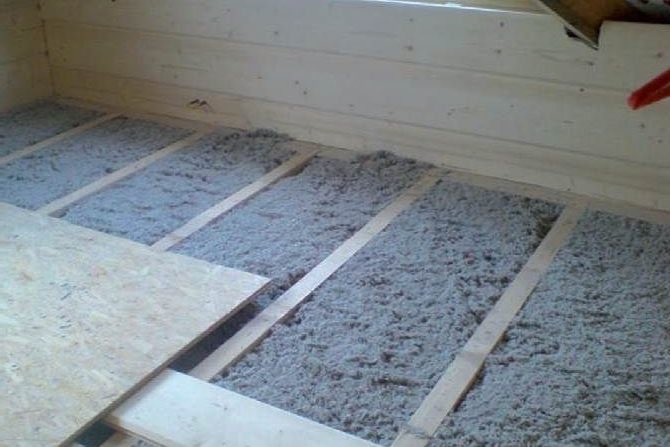

Expanded polystyrene in the market of insulation materials
Expanded polystyrene is a gas-filled material obtained on the basis of polystyrene and its derivatives by foaming them. The result is a bulk material with a closed cell structure. Expanded polystyrene can be extrusion and in the form of a plate, or it can be sold in the form of individual granules (non-pressed insulation). In this case, it can be compared with other bulk products (perlite, expanded clay, vermiculite). As an insulating material, plates are in high demand, the main structural material of which is expanded polystyrene. They win in all respects if they put expanded clay, perlite and vermiculite in one row.
Advantages of expanded polystyrene:
- high compressive strength - it lies in the range of 0.05 ... 0.1 MPA;
- low thermal conductivity - 0.042 ... 0.038 W / (mK);
- static;
- expanded polystyrene is able to withstand up to 50 freeze / thaw cycles without losing its technical characteristics;
- low coefficient of water absorption - it is only 2-3%, which makes expanded polystyrene indispensable for warming the floor in the house and basements.
Expanded polystyrene is easy to install, durable, does not change its properties under the influence of adverse environmental factors. Disadvantage: high cost compared to other thermal insulation products.
The choice of thermal insulation materials depends entirely on the financial capabilities and taste preferences of the buyer. However, regardless of the type of insulation chosen, it must be certified without fail.
Criterias of choice
The choice of insulation depends on the purpose of its application. Several types of material are used in construction: M75, M100, M150. The numbers are an indicator of the bulk density of the raw material. You also need to pay attention to the weight of the product. The smaller it is, the better the noise and heat insulation properties.
Perlite with a size of 0.16-1.25 mm is used for work. The larger the granule size, the worse the quality of the backfill. The fluidity of the material is thereby reduced. When choosing a heater, you need to pay attention to its shelf life and the integrity of the packaging - these parameters affect its technical properties. If the material has been in a humid environment for a long time, it will be useless.
How to insulate a house using perlite
Perlite as insulation is used in the form of sand (bulk insulation); component in heat-insulating products and dry ready-made building mixtures.
Perlite sand as insulation for walls
Perlite sand for arranging the thermal insulation of a house is an excellent material that can be used not only to effectively insulate a home (heat losses are reduced by 50%), but also to significantly lighten the structure of the building.
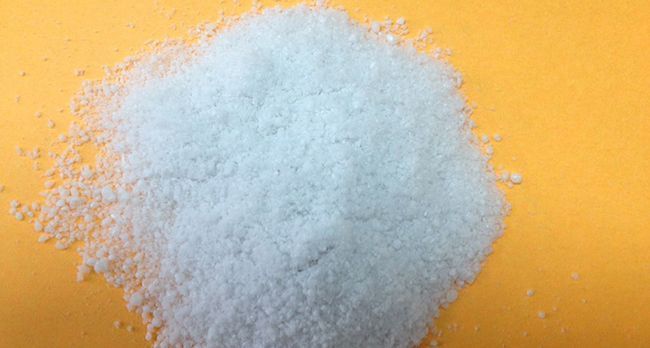

We begin the arrangement of foam perlite insulation after part of the bearing wall (internal) and external brickwork (4-5 rows) have already been erected. Backfilling of coarse perlite expanded sand (with a granule size of about 6 mm), previously dedusted, is carried out in the gap between these two walls and carefully compacted (the volume should decrease by 10%). We fill the sand by hand or using a sandblasting machine. We repeat this operation several times until the walls are fully erected. By the way, in terms of heat-saving properties, a perlite layer about 3 cm thick corresponds to a brick wall of 25 cm. When building panel houses, sand is poured between sheathing sheets (internal and external).
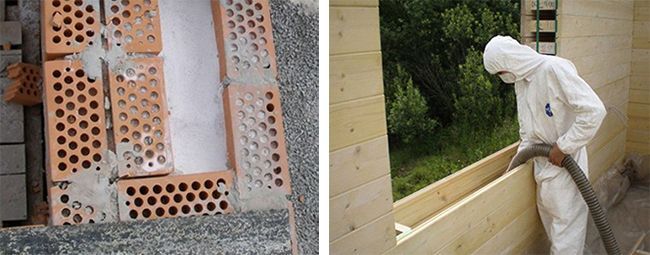

If you are insulating an old house, in the walls of which there are voids, then sand filling can be done in two ways:
- carefully pull out a few bricks from the wall and pour perlite through the hole formed;
- drill a hole in the wall (with a diameter of 30 ÷ 40 mm) and through it, using a special installation, inject heat-insulating material.
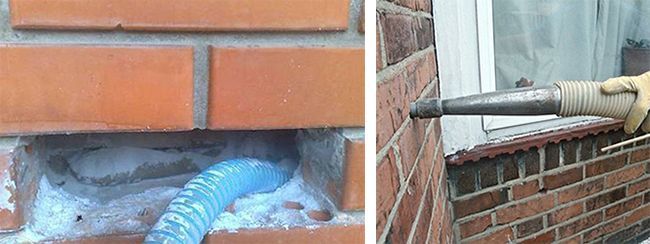

Perlite sand is a versatile non-combustible building material that has a number of advantages:
- excellent sound, noise and heat insulation properties (moreover, it can be used to insulate walls from any material);
- environmental friendliness;
- lightness (by weight);
- resistance to temperature extremes;
- durability.
Advice! You should not use perlite sand, which is a very moisture-absorbing material, as insulation in places with high humidity.
The only drawback of sand is that it is very dusty: therefore, it is recommended to slightly moisten it before use.
Floor insulation with perlite
For thermal insulation of the floors, we use expanded perlite, which we pour on the cement-sand base of the floor and level it with the building rule. The height of the sand insulation layer is the desired thickness plus 20% of the additional volume for shrinkage.
Important! The recommended minimum thickness of the perlite layer is at least 1 cm.


Unevenness and pipelines are sunk in a layer of bulk material, on top we lay slabs and flooring. If there is no basement under the house, then in order for moisture to accumulate and drain away, we put drainage pipes and absorbent pads under the perlite.
Another effective way to insulate a concrete floor can be laying a kind of "pie": we equip a perlite screed between two layers of concrete. First, we prepare a perlite solution with the following components:
- cement - 1 m2;
- perlite - 3 m2 (grade M75 or M100);
- sand - 2.2 mᶟ;
- water - 1.5 mᶟ;
- plasticizers - 3 ÷ 3.5 l.
Perlite insulation technology
The main advantage of perlite is its high level of fluidity, so it fills even the smallest cavities. The material is used to insulate walls and floors.
Wall insulation
The use of perlite for wall insulation is done in stages. The work is carried out as follows:
- Preparation of the base. It is carried out at the stage of wall construction. For insulation, it is better to use a fine sand fraction of the material. For 1 cubic meter walls will require 60-100 kg of raw materials.
- Backfill. Insulation is laid in the space between the inner and outer parts of the wall. It is filled gradually, as the structure is being built. The raw material should not be strongly rammed, but it must be compacted so that it does not shrink and the thermal insulation characteristics do not deteriorate.
As for the decoration of the walls with perlite plaster, preliminary surface preparation is also carried out here. The old decorative coating is removed from it. After the plaster has been applied and dried, a fine finish can be done. In this case, it will also perform its functions for a long time.
Floor insulation
Different types of floors can be insulated with perlite. It is often used when working with solid monolithic coatings. The sand fraction is 6 mm. The installation process is not difficult. The material is poured onto the prepared base directly from the bags. It must be distributed evenly, for which slats are used. If communications are laid on the floor, perlite sand should completely cover them. After that, you can mount the final monolithic coating.
When laying such floors, it is necessary to equip drainage branches so that it is possible to eliminate excess moisture. If the subfloor is made of wood, the perlite does not need to be compacted. Sand is poured into the cracks between the elements. Fiberglass is used to strengthen the insulation, but it can be replaced with fiberboard sheets.
Perlite is an innovative insulation material that is used to insulate walls, floors, and roofs. It has many advantages and provides reliable protection of the structure from unnecessary sound and cold. Subject to the technology of laying the material, it will last for more than a dozen years.
Pros and cons of perlite


Perlite plaster also has thermal insulation properties.
When choosing a bulk insulation, consumers have to compare several materials: expanded clay, expanded polystyrene granules, vermiculite or perlite. Each variety has features that are taken into account when making a decision. Volcanic glass bulk insulation is highly effective. The material does not shrink, like granular polystyrene foam, and does not get wet, like expanded clay. The main advantages of the insulation are:
- Low thermal conductivity of pearlite, which is provided by many voids of the porous structure of the mineral. Also, the structure of the mineral contributes to effective noise absorption.
- Low weight, allowing to reduce the total weight of the structure by up to 40%. Lightweight load-bearing walls do not require a massive foundation.
- The ability to operate in a different temperature range does not limit the use of the material.
- Fire resistance guarantees the fire safety of the insulation. He is able to stop the spread of fire.When heated, it does not emit smoke and toxic substances.
- The natural mineral is ecologically safe, there are no harmful impurities in its composition.
- Loose insulation fills the space evenly, fits tightly, leaving no cold bridges. The material does not cause difficulties when filling as foam granules.
Brittleness is the main disadvantage of pearlite. The mineral is easily destroyed, turning into dust. The material loses mass when transported in an open way, creates inconvenience during filling. Working with it requires the use of protective equipment: respirators, goggles, gloves. To make the sand less dusty, it is moistened with water before use.
Perlite's ability to absorb moisture is not always a negative characteristic. He is able to easily give off water in the form of steam. The material prevents condensation on the walls. For normal operation of the insulation, it is necessary to ensure the removal of excess moisture to the outside.
The service life of perlite sand and is it harmful to health
Perlite sand is a versatile and useful, expanded and vitreous material that is used in a fairly wide industrial and economic spectrum. Its prevalence is not impressive, but the price is within reasonable limits, which makes its use economically viable.
Average cost of perlite sand of various fractions
| Name | Cost, rub |
| Expanded perlite sand, fr 0.16-1.25, M-75, GOST 10832 | 1550 |
| Expanded perlite sand, fr 0.16-1.25, M-100, GOST 10832 | 1550 |
| Agroperlite, fr 0.16-5.0, M-150, GOST 10832 | 2200 |
The sand has a white, light and cream color, therefore it is not entirely appropriate in the agricultural sector, but it perfectly serves as a heater or a binder for various building mixtures. Since the sand is environmentally friendly and clean. It can be used in the construction of residential buildings and their insulation. If you close your eyes to problems with water absorption and some impracticality in crop production, you can confidently evaluate perlite sand at a solid five.
Since it is impossible not to take into account the shortcomings of this building material, an estimate of 4.5 will be quite objective. We hope that our tips will help you more accurately determine whether you should use this building material, after weighing all the pros and cons.
Considering the origin of the material and the process of its processing, it can be argued that it is completely environmentally friendly. Harmful substances are not part of perlite. And even during production, it remains clean. This means that the material can be used for any purpose without risk to human health. The only exceptions are cases when perlite is combined with other materials. Then the quality of the mixture should be assessed.
Glass is an essential part of the pearlite structure. The swelling technology improves the properties of the material. A long period of operation is also noted. It is believed that perlite can serve indefinitely without loss of properties.
Thermal insulating perlite plasters
The use of material based on expanded pearlite fractions helps to reduce thermal conductivity by up to 50%. Additionally, the weight of the structure is also reduced. In addition, pearlitic sand plaster makes the surface more attractive. Due to the presence of perlite in the mixture, properties such as fire resistance and sound absorption are improved.
In terms of the quality of thermal insulation, a material with a thickness of 3 cm can replace 15 cm of brickwork.
Perlite-based plaster is versatile, since it can be applied to surfaces of different materials - brick, concrete, metal, wood and cinder concrete. The advantage is the ability to paint the plaster layer without preliminary surface treatment. The same applies to wallpapering.
In addition to perlite, the mixture includes cement, water, air-entraining additives. The ratio of the components varies significantly, but the expanded sand is always taken in the same amount. Possible options for the ratio of cement and pearlite: 1: 4, 1: 5, 1: 6, 1: 8.
The less swollen sand in the mixture, the worse its thermal insulation properties. However, the highest density is noted.
Wall cake
For a better understanding of the further installation process, it is worth getting acquainted with the device of the wall cake, which consists of various layers of material. The sequence of layers is indicated in the direction from the inside of the wall to the outside:
- interior decoration materials;
- ov panels;
- penofol;
- frame racks;
- windproof material;
- lathing;
- outdoor decoration.
The wall cake is indicated for the frame house variety. For other types of structures, some materials can be excluded or added as needed.
It is worth paying attention to the need to provide a vapor barrier layer in the cake wall. Opinions differ on this, however, in most cases, a vapor barrier is not used for insulation from the inside of the room.


Wall cake device
If penofol is used in insulation from the outside, then a vapor barrier layer is necessary, because the material tends to pass vapors in only one direction (except for type C).
